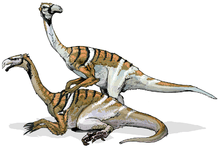Nanshiungosaurus
| Nanshiungosaurus Temporal range: Late Cretaceous, 78–70 Ma | |
|---|---|
 | |
| Skeletal restoration | |
| Scientific classification | |
| Kingdom: | Animalia |
| Phylum: | Chordata |
| Order: | Saurischia |
| Suborder: | Theropoda |
| Family: | †Therizinosauridae |
| Genus: | †Nanshiungosaurus Dong, 1979 |
| Species | |
Nanshiungosaurus is a genus of therizinosaurian theropod dinosaur from the Cretaceous of China.
Two species have been named in the genus: the type species Nanshiungosaurus brevispinus and Nanshiungosaurus bohlini.
Discovery and naming

In 1979 Nanshiungosaurus brevispinus was named and described by Dong Zhiming. The generic name refers to Nanxiong. The specific name is derived from Latin brevis, "short", and spina, "thorn", in reference to the short vertebral spines.
The holotype specimen, IVPP V4731, was near Dapingcun in Guangdong found in a layer of the Yuanpu Formation, dating from the Late Cretaceous Campanian. It consists of a partial skeleton lacking the skull but including eleven cervical, ten dorsal and six sacral vertebrae, and a bulky pelvis. It was first thought to be a small, strange sauropod characterised by a shorter but thicker neck than other sauropods.[1]
In 1997 Dong and You Hailu named and described a second species: Nanshiungosaurus bohlini, based on a skeleton found in 1992 near Mazongshan. The specific name honours the Swedish paleontologist Birger Bohlin. The holotype is IVPP V 11116, from the Early Cretaceous Upper Xinminbao Group dating from the Barremian-Aptian. It consists of only eleven cervical and five dorsal vertebrae with some ribs.[2] Dong and You presented no evidence or argumentation supporting the assignment of the species to Nanshiungosaurus. In view of the lack of synapomorphies, shared unique traits, and the large age difference with Nanshiungosaurus brevispinus it is generally considered that the second species might warrant its own genus.[3][4]
Description

Gregory S. Paul in 2010 estimated the length of Nanshiungosaurus brevispinus at five metres, the weight at six hundred kilogrammes.[5] The species distinguishes itself by the possession of twelve cervical vertebrae.[1] The number of sacral vertebrae was first determined at five,[1] later corrected to six.[6]
"Nanshiungosaurus" bohlini is a larger form, estimated by Paul at six metres and 1.3 tonnes.[4]
Phylogeny
Nanshiungosaurus brevispinus was in 1979 by Dong assigned to the Titanosaurinae, still based on the assumption it were a sauropod.[1] In 1992 the species was assigned to the Segnosauridae,[7] the group today called Therizinosauridae. In 1997 however, Dong placed both species in a separate Nanshungosauridae.[8] Cladistic analyses indicate a position for Nanshiungosaurus brevispinus that is either basal in the Therizinosauridae[3][9] or just outside that clade, basal in the Therizinosauroidea.[10] Under the definition of Therizinosauridae sensu Xu 2002, Nanshuingosaurus is by definition a therizinosaurid.[11]
See also
References
- 1 2 3 4 Z. Dong, 1979, Cretaceous dinosaurs of Hunan, China. Mesozoic and Cenozoic Red Beds of South China: Selected Papers from the "Cretaceous-Tertiary Workshop", Institute of Vertebrate Paleontology and Paleoanthropology & Nanjing Institute of Paleontology (eds.), Science Press, Nanxiong, China pp. 342-350
- ↑ Dong Z. and Yu H., 1997, "A new segnosaur from Mazongshan Area, Gansu Province, China", In: Dong (ed). Sino-Japanese Silk Road Dinosaur Expedition. China Ocean Press, Beijing. pp. 90-95
- 1 2 Lindsay E. Zanno (2010). "A taxonomic and phylogenetic re-evaluation of Therizinosauria (Dinosauria: Maniraptora)". Journal of Systematic Palaeontology 8 (4): 503–543. doi:10.1080/14772019.2010.488045.
- 1 2 Paul, G.S., 2010, The Princeton Field Guide to Dinosaurs, Princeton University Press p. 158
- ↑ Paul, G.S., 2010, The Princeton Field Guide to Dinosaurs, Princeton University Press p. 160
- ↑ Zanno, L.E., 2008, A taxonomic and phylogenetic reevaluation of Therizinosauria (Dinosauria: Theropoda): Implications for the evolution of Maniraptora, PhD Thesis, The University of Utah. pp. 329
- ↑ Z. Dong. 1992. Dinosaurian Faunas of China. China Ocean Press, Beijing pp. 188
- ↑ Z. Dong and H. Yu, 1997, "A new segnosaur from Mazongshan area, Gansu Province, China". In: Z. Dong (ed.), Sino-Japanese Silk Road Dinosaur Expedition. China Ocean Press, Beijing pp. 90-95
- ↑ L.E. Zanno, D.D. Gillette, L.B. Albright and A.L. Titus, 2009, "A new North American therizinosaurid and the role of herbivory in 'predatory' dinosaur evolution", Proceedings of the Royal Society B: Biological Sciences 276(1672): 3505–3511
- ↑ Senter, P. (2007). "A new look at the phylogeny of Coelurosauria (Dinosauria: Theropoda)." Journal of Systematic Palaeontology, 5: 429-463 (doi:10.1017/S1477201907002143).
- ↑ X. Xu, Z.-H. Zhang, P.C. Sereno, X.-J. Zhao, X.-W. Kuang, J. Han, and L. Tan, 2002, "A new therizinosauroid (Dinosauria, Theropoda) from the Upper Cretaceous Iren Dabasu Formation of Nei Mongol", Vertebrata PalAsiatica 40(3): 228-240